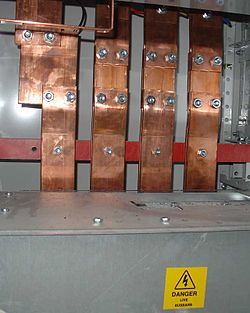| Revision as of 15:34, 5 April 2013 editShanee753 (talk | contribs)69 editsmNo edit summary← Previous edit | Revision as of 09:26, 13 April 2013 edit undoFredquint (talk | contribs)318 editsm Added reference to the derivation of "Bus" as a contraction of "Omnibus"Next edit → | ||
| Line 2: | Line 2: | ||
| ] busbars within a power distribution rack for a large building]] | ] busbars within a power distribution rack for a large building]] | ||
| In ], a '''busbar''' (also spelled ''bus bar'', ''buss bar'' or ''bussbar'') is a strip or bar of ], ] or ] that conducts ] within a ], ], ], ] or other electrical apparatus. Its main purpose is to conduct electricity, not to function as a structural member. | In ], a '''busbar''' (also spelled ''bus bar'', ''buss bar'' or ''bussbar'', with the term "bus" being a contraction of the Latin ] - meaning "for all") is a strip or bar of ], ] or ] that conducts ] within a ], ], ], ] or other electrical apparatus. Its main purpose is to conduct electricity, not to function as a structural member. | ||
| The cross-sectional size of the busbar determines the maximum amount of ] that can be safely carried. Busbars can have a cross-sectional area of as little as 10 mm<sup>2</sup> but ]s may use metal tubes of 50 mm in diameter (20 cm<sup>2</sup>) or more as busbars. An ] will have very large busbars used to carry tens of thousands of ] to the ]s that ] from molten ]. | The cross-sectional size of the busbar determines the maximum amount of ] that can be safely carried. Busbars can have a cross-sectional area of as little as 10 mm<sup>2</sup> but ]s may use metal tubes of 50 mm in diameter (20 cm<sup>2</sup>) or more as busbars. An ] will have very large busbars used to carry tens of thousands of ] to the ]s that ] from molten ]. | ||
Revision as of 09:26, 13 April 2013
| This article needs additional citations for verification. Please help improve this article by adding citations to reliable sources. Unsourced material may be challenged and removed. Find sources: "Busbar" – news · newspapers · books · scholar · JSTOR (November 2009) (Learn how and when to remove this message) |

In electrical power distribution, a busbar (also spelled bus bar, buss bar or bussbar, with the term "bus" being a contraction of the Latin omnibus - meaning "for all") is a strip or bar of copper, brass or aluminium that conducts electricity within a switchboard, distribution board, substation, battery bank or other electrical apparatus. Its main purpose is to conduct electricity, not to function as a structural member.
The cross-sectional size of the busbar determines the maximum amount of current that can be safely carried. Busbars can have a cross-sectional area of as little as 10 mm but electrical substations may use metal tubes of 50 mm in diameter (20 cm) or more as busbars. An aluminium smelter will have very large busbars used to carry tens of thousands of amperes to the electrochemical cells that produce aluminium from molten salts.
Design and placement
Busbars are typically either flat strips or hollow tubes as these shapes allow heat to dissipate more efficiently due to their high surface area to cross-sectional area ratio. The skin effect makes 50–60 Hz AC busbars more than about 8 mm (1/3 in) thickness inefficient, so hollow or flat shapes are prevalent in higher current applications. A hollow section has higher stiffness than a solid rod of equivalent current-carrying capacity, which allows a greater span between busbar supports in outdoor switchyards.
A busbar may either be supported on insulators, or else insulation may completely surround it. Busbars are protected from accidental contact either by a metal earthed enclosure or by elevation out of normal reach. Power Neutral busbars may also be insulated. Earth (safety grounding) busbars are typically bare and bolted directly onto any metal chassis of their enclosure. Busbars may be enclosed in a metal housing, in the form of bus duct or busway, segregated-phase bus, or isolated-phase bus.
Busbars may be connected to each other and to electrical apparatus by bolted, clamp, or welded connections. Often joints between high-current bus sections have matching surfaces that are silver-plated to reduce the contact resistance. At extra-high voltages (more than 300 kV) in outdoor buses, corona around the connections becomes a source of radio-frequency interference and power loss, so connection fittings designed for these voltages are used.
Busbars are typically contained inside switchgear, panel boards, or busway. Distribution boards split the electrical supply into separate circuits at one location. Busways, or bus ducts, are long busbars with a protective cover. Rather than branching the main supply at one location, they allow new circuits to branch off anywhere along the route of the busway.
Etymology
The word “bus” comes from a shortened version of “omnibus”, the Latin word that roughly means “all in one”.
See also
- Bus (computing), sometimes spelled as buss
References
- Walter A. Elmore. Protective Relaying Theory and Applications. Marcel Dekker Inc. ISBN 0-8247-9152-5.
- Paschal, John (2000-10-01). "Ensuring a Good Bus Duct Installation". Electrical Construction & Maintenance. Retrieved 2009-04-06.